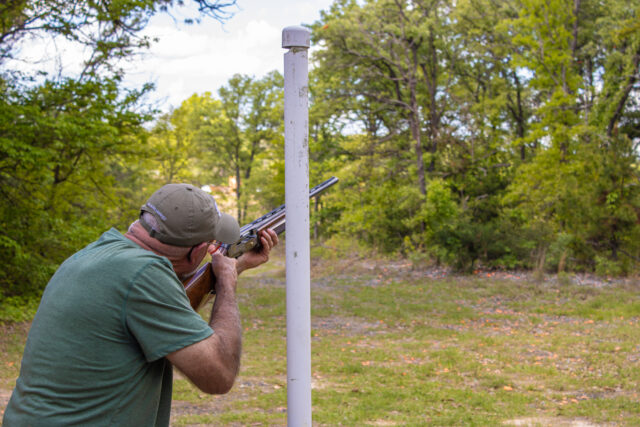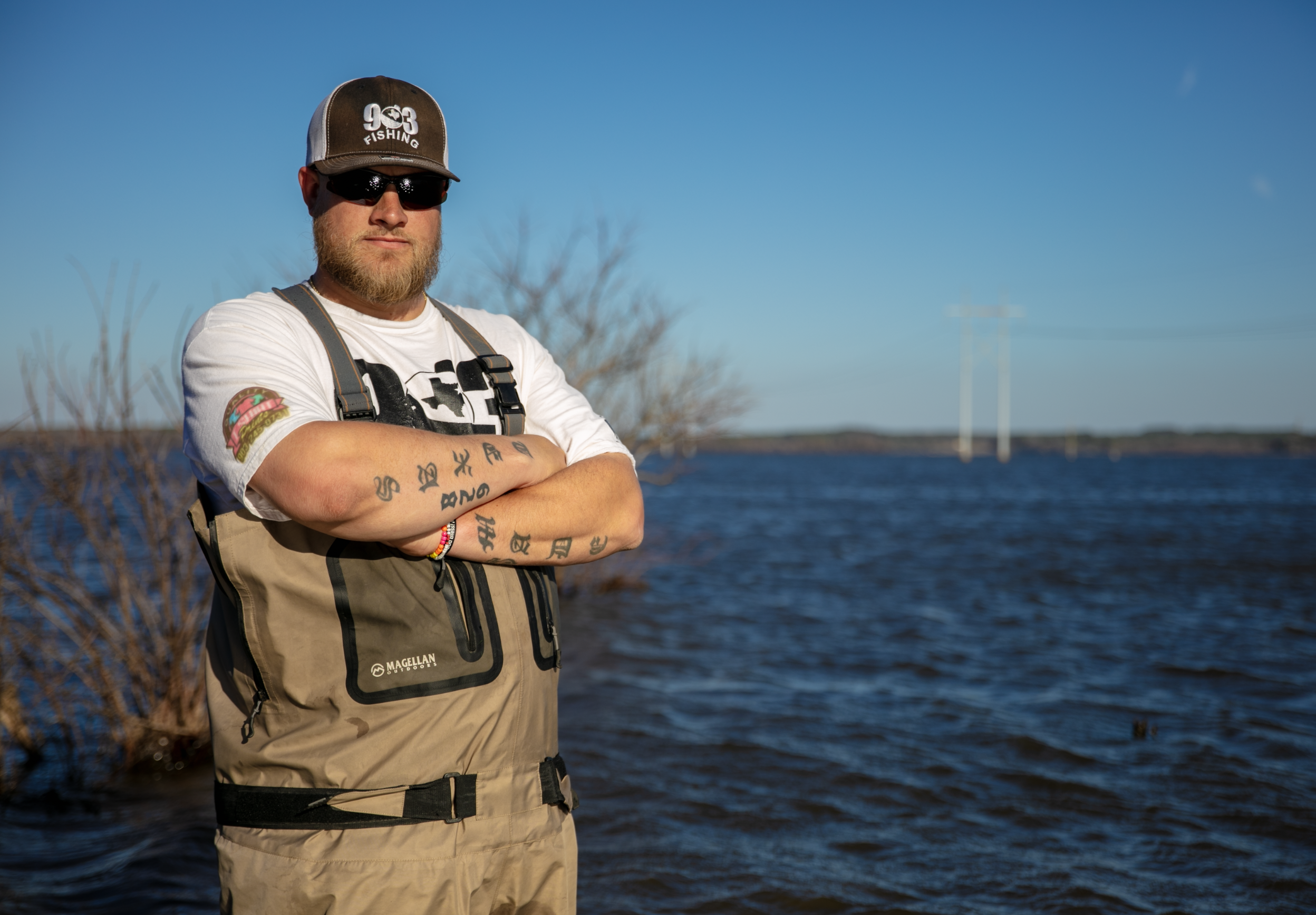By Walt Tatum
In 2023, any reference to a game is certainly assumed to be a video game. Gaming systems boast realistic graphics and interactivity. I’m here to tell you about a real interactive game. What could possibly be more interactive than shotgun sports where you feel the stock of a fine shotgun against your cheek and the recoil against your shoulder, hear the report of the shotgun blast, see the flying targets explode into a cloud of dust,and smell the aroma of burning gunpowder, all while enjoying the camaraderie of a group of friends and competitors by your side?
Sporting clays has often been explained as “Golf with a gun”. There are some similarities, but shooting clays is also very a different game. Sporting clays are shot on a “course” and have many different holes, or stations, to play. Each sporting clays course is different, designed around the lay of the land, topography, and terrain of the course. Stations are often set up in open fields, in wooded areas, creek bottoms, a pond or lake edge, hillsides, or cliffs. No two sporting clay courses are alike. The wide array and diversity of the courses is one of the main attractions to the game. Part of the fun is traveling to shoot different courses you’ve never shot before. Donnie Slider, a shooter from North Louisiana said, “My wife and I met on a sporting clays course in 2001. We both have a passion about it and take all our vacations around sporting clays events. We have shot courses together in eleven different states, so far.” The sporting clays courses are designed for the shooters to walk, or travel in a cart or buggy, down winding trails from station to station enjoying the views and nature on the way. Once at the station, the shooter has clay disc targets launched for him from hidden target throwers. The object is to shoot each flying target and break it. You get one shot for each target.
Sporting clays is one of the fastest growing sports in America with over 13 million participants in the country.
Men or women, young or old, can enjoy and successfully compete in sporting clays. While often bird hunters like to shoot a few rounds of clays prior to hunting season to hone their hunting skills; many competitors shoot sporting clays year round. Mr. Slider stated, “ The number of women and teenagers shooting sporting clays grows each year. They seem to learn and improve much faster than the men, too.”
A typical round of sporting clays allows each shooter fifty shots at fifty moving clay targets, or 100 shots at 100 targets. It typically takes two to three hours to complete. There are usually 10 to 15 stations on a course. Each station can have one, two, or three clay target throwers. The stations can be set to throw single targets, true pairs, following pairs, or report pairs. True pairs are targets thrown at the exact same time. With following pairs, one target is launched on the shooter’s call and then a few seconds later, a second target is launched. A report pair is two targets with the second being thrown after the report of the first shot. Upon arrival at each new station, a “show pair” will be thrown for the entire squad to see. This allows the shooters to prepare a strategy to successfully break both clay targets. The course can be shot by a lone player but is usually shot with a squad of up to six competitors. The squad travels from station to station with each shooter shooting each station. The shooting order rotates at each station. The shooter who shoots first at the first station, shoots second at the next station, third at the next station, and so on. When the shooter is in the station, loaded and ready, he or she will call “Pull!” and the targets are launched. Scores are kept on a scorecard marking hits and misses with Xs and 0s. The more Xs, the higher the score.
Any shotgun capable of firing two shots can be used; over-and-under double barrel, side-by-side double barrel, semi-auto, or pump action. Any gauge shotgun can be used, though 12 gauge is the standard. Many competitors prefer the additional challenge of the smaller gauges: 16, 20, 28, and 410. Guns can range from a few hundred dollars to tens of thousands of dollars. Many competitors use their hunting guns, but others have guns specifically designed for the game of sporting clays. These are most often over-and-under double barrels, or gas-operated semi autos. There is no right-or-wrong when it comes to the shotgun. Personal preference and budget play a big part in this decision. The shooter does need to make sure his shotgun fits his size and stature. The gun must fit the shooter to shoot accurate and consistent. Shells consisting of a maximum of 3 drams of powder, 1 1/8 ounce of #8 or #9
shot is preferred. Nothing larger than 7 ½ shot is acceptable. Two boxes of shells are necessary to shoot a 50 target course.
Though there is generally no dress code for the sporting clays course, each shooter will need proper footwear to traverse the rugged terrain, a cap or hat, and a shell holder or vest to carry their ammo as they traverse the course. Eye and ear protection is a requirement. Ear plugs work much better that muffs as they do not interfere with the mounting of the shotgun.
SAFETY and etiquette are stressed whether the shooter is playing the course alone or with a six man squad in a tournament. Shooters and spectators must wear eye and ear protection at all times. The action of all firearms must remain open and empty unless you are in the station ready to shoot. The gun muzzle must always be pointed up or at the ground when traveling, or downrange when ready to shoot. Never load your gun until you are on your station and ready to shoot. Only one person shoots at a time; no back-up shooting is allowed. If there is a malfunction, keep the gun pointed downrange and verbally announce “MALFUNCTION” to the other shooters, then unload or clear the malfunction. Never leave the station until the malfunction is cleared, gun is empty, and action is open. If shooting single targets, only load one shell. If shooting pairs, load only two shells. Unload before leaving the shooting station. Most courses will have a receptacle for empty hulls to be placed in. Children are welcome on the course but must have appropriate safety wear and be under close adult supervision.
Skeet, trap and other shotgun sports are shot from a standard field with targets coming from standard angles, distances, and speeds. These highly repetitive targets can get monotonous and many shooters get good enough to actually shoot the course blindfolded. Muscle memory from repetition of the exact same shots over and over allows some shooters to excel at skeet and trap. Not so with sporting clays as each station on each course is completely different. The original intent of this game was to mimic hunting scenarios in natural environments. The courses are designed to be the closest to actual wing shooting of all the shotgun sports. The stations will simulate hunting ducks, geese, teal, dove, quail, pheasant, and other upland birds, even rabbits. To excel at sporting clays, good form and instinctual shooting play a big part. Thomas Rawlins, a long time competitor and coach said, “Sporting clays is so realistic, and so much fun that I can’t stop. I shot my first round in 1992. Now, I shoot a course somewhere three days a week. I’d shoot more if I had a bigger pension! I love coaching and watching shooters improve their game.”
Though it is impossible to exactly replicate the flight of real birds, the unknown approach direction, distances, angles, and speed of the clays make it as realistic as possible. The shooters will face flushed birds, crossing shots, climbing shots, incoming as if approaching a decoy spread, overhead away shots, below your feet, or bouncing on the ground on edge- a rabbit.
Sporting clays is one of the fastest growing sports in America with over 13 million participants in the country. Competitors of diverse backgrounds, ages, abilities, and disabilities can all compete together in a fun and welcoming outdoor atmosphere.
The 4-H club, and many high schools, have shotgun sports teams that compete nationwide in the U.S. High School Clay Target League. The games of trap, skeet and sporting clays are taught and promoted to the youth. Many college scholarships are earned through this organization and others like it.
Coaches can be hired at any club but I’ve found that sporting clays enthusiasts are quick to help any newcomers free of charge. They seem to enjoy a newcomer’s success even more than their own. This family-friendly game has become so popular that there are now courses available in almost every geographical area of the country. Chances are you are very close to multiple sporting clays courses without even knowing. In my area, I am within an hours drive from five different courses. Although extremely challenging, it is a sport that even a complete novice can compete in and have a good time while watching himself improve with each call of PULL!












